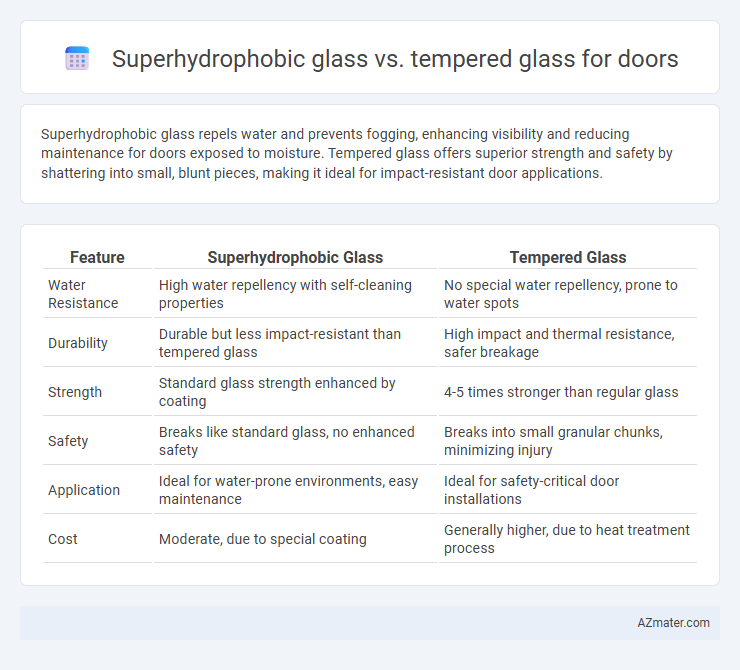Superhydrophobic glass repels water and prevents fogging, enhancing visibility and reducing maintenance for doors exposed to moisture. Tempered glass offers superior strength and safety by shattering into small, blunt pieces, making it ideal for impact-resistant door applications.
Table of Comparison
| Feature | Superhydrophobic Glass | Tempered Glass |
|---|---|---|
| Water Resistance | High water repellency with self-cleaning properties | No special water repellency, prone to water spots |
| Durability | Durable but less impact-resistant than tempered glass | High impact and thermal resistance, safer breakage |
| Strength | Standard glass strength enhanced by coating | 4-5 times stronger than regular glass |
| Safety | Breaks like standard glass, no enhanced safety | Breaks into small granular chunks, minimizing injury |
| Application | Ideal for water-prone environments, easy maintenance | Ideal for safety-critical door installations |
| Cost | Moderate, due to special coating | Generally higher, due to heat treatment process |
Introduction to Door Glass Options
Superhydrophobic glass offers superior water-repellent properties, making it ideal for doors exposed to harsh weather conditions, as it prevents water buildup and reduces maintenance. Tempered glass provides enhanced strength and safety by undergoing thermal treatment to resist impact and shattering, commonly used in doors requiring durability and security. Both options serve specific functional needs, with superhydrophobic glass emphasizing cleanliness and weather resistance, while tempered glass focuses on structural integrity and safety compliance.
What is Superhydrophobic Glass?
Superhydrophobic glass features an advanced nano-coating that repels water and prevents dirt accumulation, enhancing visibility and reducing maintenance for doors in humid or rainy environments. This innovative glass surface achieves water contact angles greater than 150 degrees, causing droplets to bead and roll off effortlessly, unlike tempered glass which focuses primarily on impact resistance and safety. By integrating superhydrophobic technology, door glass becomes more durable against weathering, maintaining clarity and cleanliness without frequent cleaning compared to traditional tempered glass.
What is Tempered Glass?
Tempered glass is a type of safety glass processed by controlled thermal or chemical treatments to increase its strength compared to normal glass. It is designed to shatter into small, blunt pieces rather than sharp shards when broken, reducing the risk of injury. Commonly used for doors, tempered glass offers enhanced durability, impact resistance, and thermal stability, making it ideal for high-traffic or safety-critical applications.
Durability Comparison: Superhydrophobic vs Tempered
Superhydrophobic glass provides exceptional water repellency, reducing surface staining and corrosion, which enhances its long-term clarity and resistance to environmental wear. Tempered glass offers superior mechanical strength and impact resistance, making it less prone to breakage under stress compared to standard glass types. While tempered glass excels in structural durability, superhydrophobic glass improves surface longevity by preventing water damage, creating a complementary balance in door applications.
Water and Stain Resistance
Superhydrophobic glass offers superior water resistance by causing water droplets to bead and roll off the surface, minimizing water accumulation and reducing the risk of staining. Tempered glass, while stronger and more impact-resistant, does not have inherent water-repellent properties, making it more prone to water spots and stains over time. The hydrophobic coating on superhydrophobic glass enhances stain resistance, making it ideal for door applications exposed to moisture and dirt.
Safety and Security Aspects
Superhydrophobic glass offers enhanced safety by repelling water and reducing slip hazards, while tempered glass provides superior impact resistance and shattering prevention due to its heat-treated structure. Tempered glass is designed to break into small, blunt pieces, minimizing injury risk during accidents, whereas superhydrophobic glass primarily improves surface cleanliness and durability without significantly increasing impact strength. For door security, tempered glass remains the preferred choice due to its toughness and ability to withstand forced entry attempts more effectively than standard superhydrophobic coatings.
Maintenance and Cleaning Differences
Superhydrophobic glass features a nanoscale coating that repels water, dirt, and oils, significantly reducing the frequency and effort required for cleaning, making it ideal for high-traffic doors exposed to environmental contaminants. Tempered glass, although stronger and more resistant to impact due to its heat-treatment process, does not possess self-cleaning properties, requiring regular manual cleaning to remove smudges and grime. Maintenance for superhydrophobic glass primarily involves gentle rinsing to preserve its coating, while tempered glass demands standard cleaning methods using glass cleaners and cloths to maintain clarity and appearance.
Aesthetic Impact on Door Design
Superhydrophobic glass enhances door design by maintaining a crystal-clear, spotless surface that resists water, dirt, and fingerprints, ensuring long-lasting visual appeal and minimal maintenance. Tempered glass provides safety and durability with its strength and shatter-resistant properties but may accumulate smudges and water spots, slightly diminishing its aesthetic over time. The choice influences the door's overall look, where superhydrophobic glass offers a sleek, pristine finish that elevates modern design aesthetics.
Cost Analysis: Investment and Longevity
Superhydrophobic glass typically commands a higher upfront investment due to its advanced coating technology that repels water and reduces maintenance needs, enhancing long-term durability and cleanliness. Tempered glass, while more affordable initially, offers robust impact resistance and safety but may incur higher costs over time from cleaning, replacement, and wear-related degradation. Evaluating total cost of ownership, superhydrophobic glass can provide better longevity and reduced upkeep expenses compared to tempered glass, particularly in environments exposed to moisture and frequent soiling.
Which Glass is Best for Your Door?
Superhydrophobic glass offers superior water repellency and self-cleaning properties, making it ideal for exterior doors exposed to harsh weather conditions. Tempered glass provides exceptional strength and safety by shattering into small, blunt pieces upon impact, suitable for secure entry doors. Choosing the best glass for your door depends on prioritizing weather resistance and maintenance (Superhydrophobic) versus impact resistance and safety (Tempered).

Infographic: Superhydrophobic glass vs Tempered glass for Door
 azmater.com
azmater.com